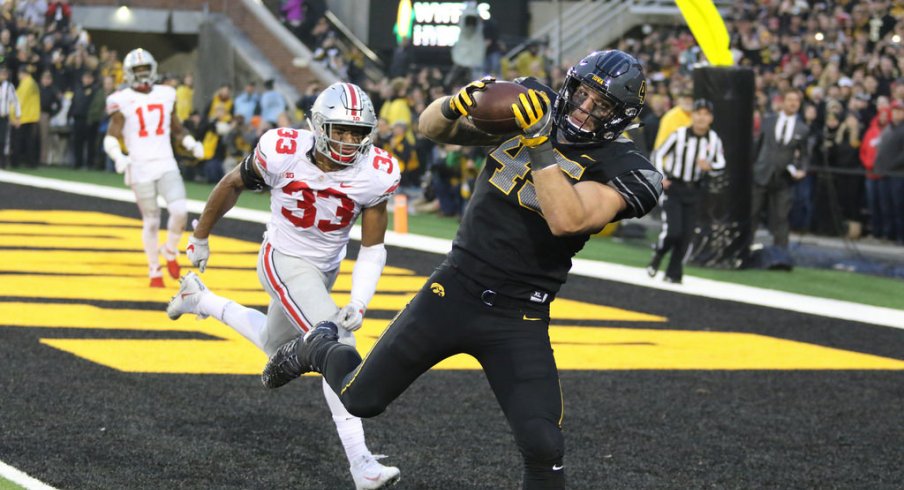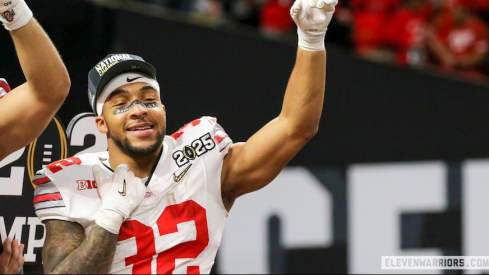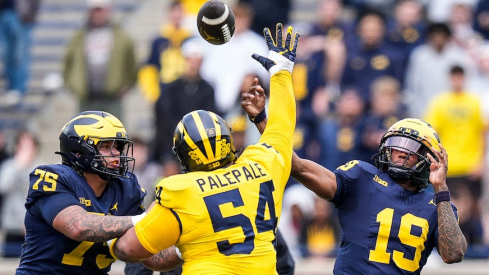“Champions don’t do extraordinary things. They do ordinary things, but they do them without thinking, too fast for the other team to react. They follow the habits they’ve learned.”
In 2012, Charles Duhigg became a star in the business world following the publication of his award-winning book, The Power of Habit: Why We Do What We Do in Life and Business. Readers across the world immediately latched onto concepts like "The Habit Loop," which describes the way the human brain automatically decides which habit to trigger based on the familiar cues it encounters in the world around us.
To tell this story, Duhigg spent time with many different kinds of leaders, from a former treasury secretary to Super Bowl-winning coach, Tony Dungy. As Duhigg notes, while Jon Gruden may have been leading the 2002 Tampa Bay Buccaneers when they hoisted the Lombardi Trophy 15 years ago, the team's culture, specifically on defense, had been shaped by Dungy. Likewise, although the 2007 Indianapolis Colts had an explosive offense led by Peyton Manning, their defense was a fundamentally sound bunch that rarely made mistakes.
That Duhigg spent so much time with a coach that spent most of his career on the defensive side of the ball may have just been a coincidence. But the lessons learned from the passages with Dungy should echo through the halls of the Woody Hayes Athletic Center this week, as the Ohio State defense looks for answers after giving up 55 points and nearly seven yards-per-play to the 102nd best offense in the FBS.
Though some still want to place blame on J.T. Barrett for turning the ball over four times, or on the offensive coaching staff for not getting the ball to the running backs, Saturday's loss in Kinnick Stadium falls first and foremost on the shoulders of the Buckeye defense. By acting as though a half-dozen more carries for J.K. Dobbins may have somehow erased the nearly 500 yards of offense surrendered to the Hawkeyes on that afternoon, it diminishes the past efforts of the Silver Bullets, who kept bad Buckeye offenses in countless contests over the years.
What happened in Iowa City was a failure at all levels of the defense, as a unit that manhandled the "pro-style" looks of Rutgers and Nebraska earlier this year looked as though they'd never seen an I-formation or two-tight end set in their lives. Though Barrett spotted the opponent with seven points before they ever took the field, the defense would go on to surrender scoring drives of 63, 80, 89, 78, 60, and 47 yards, leaving many to wonder what, exactly, they'd just seen from a group that hadn't looked this bad in Big Ten play for decades.
The problems began almost immediately, as the Hawkeye ground game seemed to move the ball at will. While Greg Schiano asked his defensive line to slant towards the strength, a move that is often welcomed by teams running the lateral outside zone "stretch" play from the I-formation (which Iowa has run for the entirety of Kirk Ferentz's 18-year tenure), the linebackers and defensive backs behind them seemed to have no discipline in their responsibilities, known as "run fits."
All too often, the Iowa offense would confuse the OSU defense with basic motions, leaving cutback lanes and outside edges uncovered as the Buckeyes scrambled to determine who was supposed to be in which gap.

As noted by the announcers on TV, Iowa was breaking their own tendencies, as they threw the ball on 14 of their 28 first downs despite only doing so 36% of the time this season. But the Buckeye defense was often caught completely flat-footed in such situations, biting on play-action and leaving windows wide open for quarterback Nate Stanley.

Yet the Hawkeyes weren't showing a new playbook by any means, as they executed their typical, lead-zone running game, west coast passing game, and looked down the field after play-action. The Buckeyes clearly weren't ready for it, though, as they failed to anticipate play-calls or execute simple tasks like running underneath the "rub" routes set up to slow down defenders in man-coverage, as Malik Harrison did on a crucial third down here:
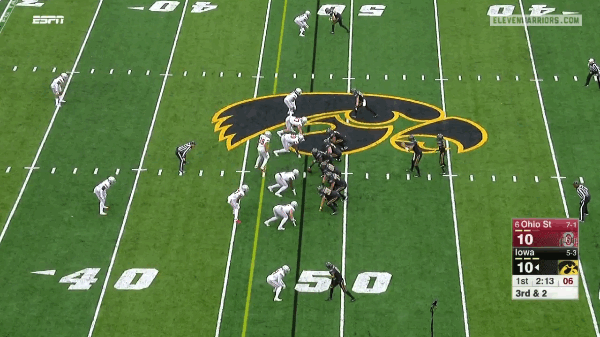
Once the Hawkeye coaches recognized the trouble they were giving their opponents by implementing simple shifts and motions, they doubled-down. Throughout the first three quarters, the Iowa offense moved tight end Noah Fant around the formation in myriad ways, sometimes even covering him and making him ineligible as a receiver, knowing the Buckeye defense wouldn't know how to react.
But Schiano's defense clearly wasn't prepared for such maneuvers, as they struggled to implement coverage checks late in the snap count, often calling to one another as the ball was snapped and leaving receivers open.
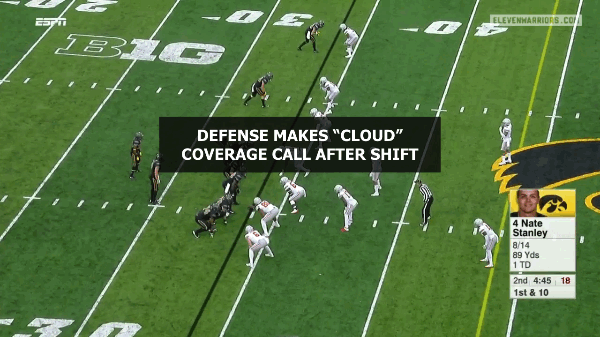
These small cues didn't go unnoticed by the Iowa staff, either. Later on the same drive, Nick Bosa was ejected for targeting after the Buckeyes had appeared to have finally gotten a stop on third down, and offensive coordinator went right back to the same play that had given the OSU secondary trouble, a four verticals concept from a double-tight end "nub" set.
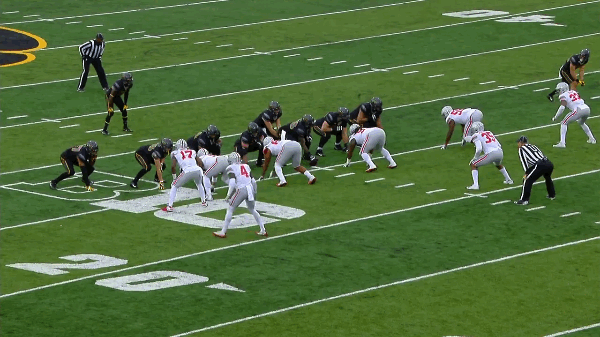
This is as good a time as any to tip our hats to Stanley, Fant, and the Iowa offense, who executed their game plan perfectly. The young Hawkeye line stood tall against the talented Ohio State front, keeping Stanley clean so he could fit the ball into very tight windows, which he did all day long.
But the Buckeyes' self-inflicted wounds couldn't be overcome this week as they had in the past. Rutgers and Nebraska were unable to take advantage when the scarlet and gray secondary screwed up, but the sophomore quarterback from Wisconsin showed many that he could be the Big Ten's next great hope to finally produce a quarterback worthy of a first-round draft pick.
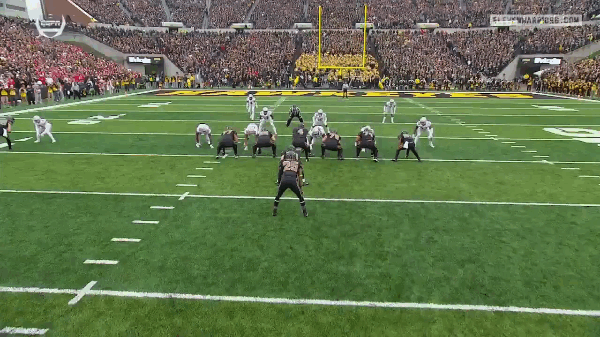
Much of this confusion appeared, at least to an outsider, as though the Buckeyes were suffering from "paralysis by analysis," and that the defense was thinking far more than they were reacting. For those unfamiliar with coach-speak, that essentially means they didn't know what they were seeing, and thus, didn't know how to react accordingly (i.e. relying on the good habits they'd built throughout the season), which is a failure on the part of the coaches.
In the NFL, coaches typically spend a great deal of time identifying the tendencies of a particular opponent and designing schemes and adjustments for each situation. It's on each position coach to then ensure their group knows each of those adjustments, which is largely done in meeting rooms and walk-throughs.
What doesn't happen very often in the NFL anymore is skill development, as most players are expected to arrive in NFL camps as nearly-finished products ready to contribute on day one. As such, it's quite difficult not to notice that the units which struggled most against the Hawkeyes are led by men who were most recently working at the professional level before joining Urban Meyer's staff.
Greg Schiano is in charge of the safeties in addition to his duties as coordinator, and Billy Davis, who called the defensive plays in San Francisco, Arizona, and Philadelphia, leads the linebackers. While both units lost star players from a year ago in Malik Hooker and Raekwon McMillan, training camp opened three months ago, and the kinds of failures seen on Saturday should be inexcusable at this point in the season.
Perhaps no situation amplified these issues more than when Iowa was near the goal-line, as the Buckeye linebackers and safeties, for the most part, looked clueless against simple concepts found in nearly every playbook.
While individual failures may fall on a single player, what we saw last weekend was the failure of an entire unit to properly line up and execute a game plan, which will undoubtedly lead to some uncomfortable conversations between Urban Meyer and two of his closest friends in the coaching world. Schiano's answers to the problems posed by Iowa seemed to be increasingly complex, calling for a multitude of man and zone coverages that left his unit confused and unsure.
To make matters worse, the Buckeye defense has little time to fix these issues, as both Michigan State this weekend and Michigan in three weeks feature attacks similar to the one we just saw upend the Silver Bullets. Should they make it through those tests, they'll then get the pleasure of facing the best pro-style offense in the league as a battle with Wisconsin for the Big Ten title looms in the distance.
To do so, they must get back to basics - literally. The Buckeyes' base, 4-3 Over defense with Quarters coverage was largely absent against the Hawkeyes, replaced by a mix of Cover-1 and 2-Man schemes that placed Buckeye defenders in solo coverage, as well as a handful of Cover-3 varieties like Sky, Cloud, and Buzz. While all of these schemes can work against teams in 12 or 21 personnel, the Buckeyes haven't seemed to master any of them.
Defensive coaches often tell their players to "click and close," meaning process what they see quickly (click) and then use their athletic ability to go make a play (close). Like every team Urban Meyer or his predecessors in Columbus have put on the field for decades, this Buckeye defense certainly isn't lacking what's needed to execute the latter part of that formula. However, it's up to Meyer's staff to ensure those athletes master the former piece of the equation first.
